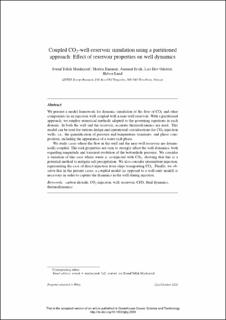| dc.description.abstract | We present a model framework for dynamic simulation of the flow of (Formula presented.) and other components in an injection well coupled with a near-well reservoir. With a partitioned approach, we employ numerical methods adapted to the governing equations in each domain. In both well and reservoir, accurate thermodynamics are used. This model can be used for various design and operational considerations for (Formula presented.) -injection wells, that is, the quantification of pressure and temperature transients, and phase composition, including the appearance of a water-rich phase. We study cases where the flow in the well and the near-well reservoir is dynamically coupled. The rock properties are seen to strongly affect the well dynamics, both regarding magnitude and transient evolution of the bottom-hole pressure. We consider a variation of this case where water is co-injected with (Formula presented.), showing that this is a potential method to mitigate salt precipitation. We also consider intermittent injection, representing the case of direct injection from ships transporting (Formula presented.). Finally, we observe that in the present cases, a coupled model (as opposed to a well-only model) is necessary in order to capture the dynamics in the well during injection. © 2020 Society of Chemical Industry and John Wiley & Sons, Ltd. © 2020 Society of Chemical Industry and John Wiley & Sons, Ltd. | en_US |
